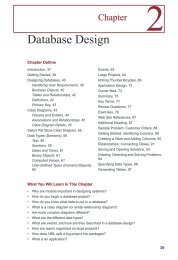Revision History - Jerry Post
Revision History - Jerry Post
Revision History - Jerry Post
You also want an ePaper? Increase the reach of your titles
YUMPU automatically turns print PDFs into web optimized ePapers that Google loves.
Amazon.com<br />
In 1994, with a handful of programmers and a few thousand dollars in workstations<br />
and servers, Jeff Bezos set out to change the retail world when he created Amazon.com<br />
(ticker: AMZN). Shel Kaphan, Amazon’s first programmer, assisted by others, including<br />
Paul Barton-Davis, used a collection of tools to create Web pages based on a database of 1<br />
million book titles compiled from the Library of Congress and Books in Print databases.<br />
Kaphan notes that “Amazon was dependent on commercial and free database systems, as<br />
well as HTTP server software from commercial and free sources. Many of the programming<br />
tools were free software” [Collett 2002]. In July 1995, Amazon opened its website for sales.<br />
Using heavily discounted book prices (20 to 30 percent below common retail prices); Amazon<br />
advertised heavily and became the leading celebrity of the Internet and e-commerce.<br />
Sales and Relationships<br />
Amazon made its initial mark selling books, and many people still think of the company<br />
in terms of books. However, almost from the start, the company has worked to expand<br />
into additional areas—striving to become a global retailer of almost anything. Some of the<br />
main events include: 1995 books, 1998 music and DVD/video, 1999 auctions, electronics,<br />
toys, zShops, home improvement, software, and video games [1999 annual report].<br />
By the end of 1999, the company had forged partnerships with several other online<br />
stores, including Ashford.com, Audible, Della.com, drugstore.com, Gear.com,<br />
Greenlight.com, HomeGrocer.com, Kozmo.com, living.com, NextCard.com, Pets.com, and<br />
Sothebys. Of course, most of those firms and websites later died in the dot-com crash of<br />
2000/2001.<br />
Amazon also established partnerships with several large retailers, including Target,<br />
Toys ‘R’ Us, Babies ‘R’ Us, and Circuit City. Effectively, Amazon became a service organization<br />
to manage the online presence of these large retailers. However, it also uses its distribution<br />
system to deliver the products. The Circuit City arrangement is slightly different<br />
from the others—customers can pick up their items directly from their local stores [Heun<br />
August 2001].<br />
By mid-2003, the Web sales and fulfillment services amounted to 20 percent of Amazon’s<br />
sales. Bezos points out that most companies realize that only a small fraction of their<br />
total sales (5 to 10 percent) will come from online systems, so it makes sense to have Amazon<br />
run those portions [Murphy 2003].<br />
In 2001, Amazon took over the website run by its bricks-and-mortar rival Borders.<br />
In 2000, Borders lost $18.4 million on total online sales of $27.4 million [Heun April 2001].<br />
Also in 2001, Amazon partnered with Expedia to offer travel services directly from the<br />
Amazon site. However, in this case, the Amazon portion consists of little more than an advertising<br />
link to the Expedia services [Kontzer 2001]. The deals in 2001 continued with a<br />
twist when Amazon licensed its search technology to AOL. AOL invested $100 million in<br />
Amazon and pays an undisclosed license fee to use the search-and-personalization service<br />
on Shop@AOL [Heun July 2001]. In 2003, Amazon launched a subsidiary just to sell its<br />
Web-sales and fulfillment technology to other firms. Bezos noted that Amazon spends about<br />
$200 million a year on information technology (a total of $900 million to mid-2003). The<br />
purpose of the subsidiary is to help recover some of those costs—although Bezos believes<br />
they were critically necessary expenditures [Murphy 2003].<br />
2







